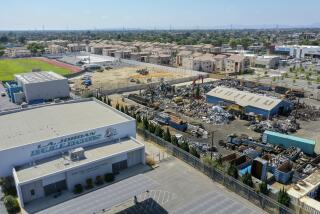Trial Begins on Blast in MTA Tunnel
Just hours before a July 1994 explosion and fire ripped through a Metro Rail subway tunnel, severely burning a welder and critically injuring two others, an inspector warned that improperly stored acetylene and oxygen tanks were a safety hazard, an attorney representing one of those injured told a civil court jury Thursday.
In his opening arguments in Los Angeles Superior Court, attorney Mark P. Robinson accused the Metropolitan Transportation Authority and Parsons-Dillingham, the firm responsible for overseeing construction of that part of the subway, of having âa conscious disregard for safety.â
But attorney Robert Cardwell, representing the MTA and Parsons-Dillingham against lawsuits filed by the welders, countered that ârun-of-the-mill ordinary carelessnessâ was responsible for the explosion, not a lack of concern about safety.
On the morning of the explosion, Cardwell acknowledged, a Parsons-Dillingham inspector had seen the acetylene and oxygen tanks improperly stored near a huge digging machine that welders had been dismantling. âWhat he saw, he did not see as an imminently dangerous situation,â Cardwell said.
The inspector called it to the attention of a mechanic working for Shea-Kiewit-Kenny, the contractor building the tunnel, but no action was taken because âthey didnât stop work on a regular basis for conditions that werenât imminently dangerous,â Cardwell said.
Later that afternoon, a welder used an acetylene torch to cut a heavy steel mounting bracket that fell onto one of the acetylene tanks. That sparked a fire, which then caused an adjacent acetylene tank to explode, officials later concluded.
*
After the explosion, state and federal officials levied $447,125 in fines against Shea-Kiewit-Kenny for safety violations. Five of the 15 citations issued were for âwillful seriousâ violations--which imply that the contractor knew of the hazards but ignored them.
Cal/OSHA officials cited the contractor for, among other things, failing to secure the steel bracket before it was cut loose, failing to provide fire protection equipment when cutting torches were in use and failing to inform all employees of emergency response plans.
Among the violations were failure to place welding cylinders far enough from the cutting operations so that sparks would not reach them and storing more gas tanks in the tunnel than permitted. The contractor appealed all of the citations.
The lawsuits seeking damages from the MTA and Parsons-Dillingham were filed by the three welders injured in the blast.
Dale Gibson suffered severe burns over 94% of his body, Andres Gutierrez was burned over 35% of his body, and Michael Willis was less severely hurt. All worked for Shea-Kiewit-Kenny.
Robinson said that Gibson, a foreman, has needed more than $2 million in medical treatment, has had more than 40 surgeries in an effort to repair skin damage, and will need many more operations in coming years. Without considering the pain and suffering, Robinson said, Gibsonâs medical expenses and lost income will amount to at least $7.5 million.
While agreeing that the explosion was a âhorrific eventâ and the injuries suffered by the welders were severe, Cardwell argued that the primary responsibility for worker safety rested with Shea-Kiewit-Kenny. âThis accident arose directly out of their work,â he said.
Robinson told the jury that inspectors had issued 299 safety warnings over a 2 1/2-year period involving the dangers of improperly stored acetylene and oxygen tanks being used by welders in the tunnel. âNot once in a 2 1/2-year period did they ever stop work,â he said.
*
He said he will present expert testimony that acetylene tanks improperly left resting on their side are 4,000 times more dangerous than those left upright.
Additionally, Robinson said, 141 safety warnings had been issued concerning tunnel fire extinguishers that were absent or were not fully operational.
A majority of the 299 construction safety reports concerning the tanks were written by Shea-Kiewit-Kenny personnel, Cardwell said, but some were done by Parsons-Dillingham. Copies of the reports and action taken are sent to the MTA, the construction management firm and the contractor.
More to Read
Sign up for Essential California
The most important California stories and recommendations in your inbox every morning.
You may occasionally receive promotional content from the Los Angeles Times.










